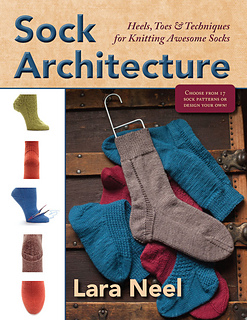I tweeted just when Sock Architecture came out that I was really excited about the book – just based on the glimpse of the pictures I saw on Ravelry, this book was for me.

Sock Architecture is a book that focuses on the knit socks – no adornments, just the facts. The photography reflects this dedication: the socks, heels and other techniques are photographed against a plain white background, absent of more artistic styling. It reads more like a textbook and less like an art book. The pages lack a glossy texture and Neel doesn’t shy away from the math.
I’m not complaining – this is the book I’ve been waiting for.
It embraces the math (no surprise, Neel’s blog is titled Math4Knitters), and talks about socks the way I think about them – in ratios and proportions. It doesn’t dumb down the fact that knitting is a thinking person’s hobby; that there has to be a part of each knitter that can see, can think, a project into existence.
I’m about halfway through my second re-read of the book, and I thought I’d make a list of my favorite parts thus far:
- The history part of the book is short, but informative. I now have several places where I’m going to go to do my own research. If you have an electronic copy of the book, the links to the pieces she’s talking about are great.
- The mini-heels, demonstrating how each heel fits on the same model. So great for a couple of reasons: acknowledges that not every heel is for every foot, and that you can substitute out one heel for another.
- The attention to detail given to the different types of heel, toe, and sock construction.
- The loving discussion of gussets, why they’re helpful, and why you nearly always want one.
- Several-fool proof ways of measuring feet.


